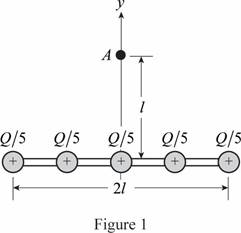
Concept explainers
(a)
The expression for the electric field at point A located at a distance l above the mid-point of the rod.
(a)
Answer to Problem 79PQ
The expression for the electric field at point A located at a distance l above the mid-point of the rod is
Explanation of Solution
Sketch the diagram showing the five charges.

The x component of the electric field is zero based on the geometry.
Write the expression for the y component of the electric field.
Here,
Write the equation for the total electric field.
Conclusion:
Substitute
Substitute
Substitute
Substitute
Substitute
Substitute equations (III), (IV), (V), (VI) and (VII) in equation (II) to find
Thus, the expression for the electric field at point A located at a distance l above the mid-point of the rod is
(b)
The electric field at point A located at a distance l above the mid-point of the rod using the exact expression.
(b)
Answer to Problem 79PQ
The electric field at point A located at a distance l above the mid-point of the rod using the exact expression is
Explanation of Solution
Write the exact expression for the total electric field.
Here,
Conclusion:
Substitute
Thus, the electric field at point A located at a distance l above the mid-point of the rod using the exact expression is
(c)
Compare the approximate result with the exact result.
(c)
Answer to Problem 79PQ
The approximate result is
Explanation of Solution
Find the ratio of the approximate result with the exact result.
Conclusion:
Thus, the approximate result is
Want to see more full solutions like this?
Chapter 24 Solutions
Physics for Scientists and Engineers: Foundations and Connections
- In an isothermal process, you are told that heat is being added to the system. Which of the following is not true? (a) The pressure of the gas is decreasing. (b) Work is being done on the system. (c) The average kinetic energy of the particles is remaining constant. (d) The volume of the gas is increasing. (e) Work is being done by the system.arrow_forwardNo chatgpt pls will upvotearrow_forward8.114 CALC A Variable-Mass Raindrop. In a rocket-propul- sion problem the mass is variable. Another such problem is a rain- drop falling through a cloud of small water droplets. Some of these small droplets adhere to the raindrop, thereby increasing its mass as it falls. The force on the raindrop is dp dv dm Fext = + dt dt dt = Suppose the mass of the raindrop depends on the distance x that it has fallen. Then m kx, where k is a constant, and dm/dt = kv. This gives, since Fext = mg, dv mg = m + v(kv) dt Or, dividing by k, dv xgx + v² dt This is a differential equation that has a solution of the form v = at, where a is the acceleration and is constant. Take the initial velocity of the raindrop to be zero. (a) Using the proposed solution for v, find the acceleration a. (b) Find the distance the raindrop has fallen in t = 3.00 s. (c) Given that k = 2.00 g/m, find the mass of the raindrop at t = 3.00 s. (For many more intriguing aspects of this problem, see K. S. Krane, American Journal of…arrow_forward
- 8.13 A 2.00-kg stone is sliding Figure E8.13 F (kN) to the right on a frictionless hori- zontal surface at 5.00 m/s when it is suddenly struck by an object that exerts a large horizontal force on it for a short period of 2.50 time. The graph in Fig. E8.13 shows the magnitude of this force as a function of time. (a) What impulse does this force exert on t (ms) 15.0 16.0 the stone? (b) Just after the force stops acting, find the magnitude and direction of the stone's velocity if the force acts (i) to the right or (ii) to the left.arrow_forwardPlease calculate the expectation value for E and the uncertainty in E for this wavefunction trapped in a simple harmonic oscillator potentialarrow_forwardIf an object that has a mass of 2m and moves with velocity v to the right collides with another mass of 1m that is moving with velocity v to the left, in which direction will the combined inelastic collision move?arrow_forward
- Please solve this questionarrow_forwardPlease solvearrow_forwardQuestions 68-70 Four hundred millilitres (mL) of a strong brine solution at room temperature was poured into a measuring cylinder (Figure 1). A piece of ice of mass 100 g was then gently placed in the brine solution and allowed to float freely (Figure 2). Changes in the surface level of the liquid in the cylinder were then observed until all the ice had melted. Assume that the densities of water, ice and the brine solution are 1000 kg m-3, 900 kg m3 and 1100 kg m3, respectively. 68 Figure 1 400 400 Figure 2 1m² = 1x10 mL After the ice was placed in the brine solution and before any of it had melted, the level of the brine solution was closest to 485 mL. B 490 mL. C 495 mL. Displaced volume by ice. D 500 mL. weight of ice 69 The level of the brine solution after all the ice had melted was A 490 mL B 495 mL D 1100kg/m² = 909 xious mis 70 Suppose water of the same volume and temperature had been used instead of the brine solution. In this case, by the time all the ice had melted, the…arrow_forward
 Physics for Scientists and Engineers: Foundations...PhysicsISBN:9781133939146Author:Katz, Debora M.Publisher:Cengage Learning
Physics for Scientists and Engineers: Foundations...PhysicsISBN:9781133939146Author:Katz, Debora M.Publisher:Cengage Learning
